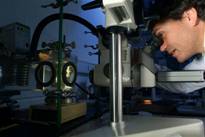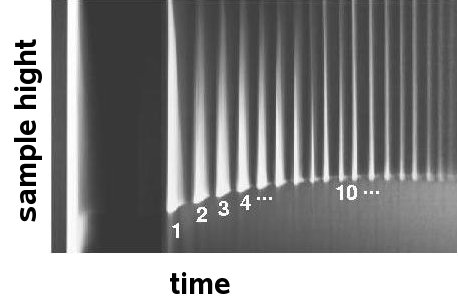Research - Hydrodynamics
Phase separation in binary mixtures
Phase separation under slow cooling/heating: |

|

Figure 1: (a) Experimental set-up, (b) Sample cell, (c) Position in the phase diagram,
(d) Observation of camera 1 as a function of time.
We developed an experimental setup where simultaneous video-microscopy and shadow-graph measurements can be performed on mixtures subjected to an arbitrary temporal temperature evolution. In particular, it can be adjusted to fix the thermodynamic driving force, which characterizes the rate of change of the composition of the coexisting phases. With this novel technique both the number of oscillations and the temperature interval where oscillations are observed increase significantly. This technique can easily be applied to a great variety of binary mixtures, permitting detailed investigations of their phase-separation kinetics under slowly ramping temperature.

Figure 2: Oscillatory behavior as observed with camera 1 in a space time plot.
References
- Y. Hayase, M. Kobayashi, D. Vollmer, H. Pleiner, G. K. Auernhammer;
Asymmetric oscillations during phase separation under continuous cooling - A simple model;
J. Chem. Phys., 129, (2008) 184109. - G. K. Auernhammer, D. Vollmer, and J. Vollmer;
Oscillatory instabilities in phase separation of binary mixtures: Fixing the thermodynamic driving;
J. Chem. Phys. 123 (2005), 134511. - J. Vollmer, G. K. Auernhammer, and D. Vollmer;
Minimal Model for Phase Separation under Slow Cooling;
Phys. Rev. Lett. 98 (2007), 115701.

